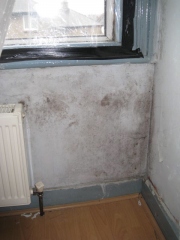
020 8531 5656
info@breway.com
How to deal with damp in your house
Living in a damp house can pose serious health hazards and hence one must take immediate steps to treat and cure dampness when encountered. A damp house can give rise to respiratory problems and also encourage the emergence of moulds and mites that can create a very unhealthy environment for one to live in. There can be various kids of dampness like rising dampness, penetrating dampness or plain condensation. Rising dampness is caused when water from the ground enters a home via capillary action. This is characterized by decaying skirting boards, peeling wallpaper, decaying timber floors, discoloration and staining. Penetrating dampness is caused by water leaking from defective gutter or down pipes, faulty flashings and cracked rendering. In this case you will see damp patches on walls, floors and ceilings. Condensation is the most common cause of dampness in a house and is caused by water from the air. Poor heating and improper ventilation are responsible for condensation in most cases.
Parler ordonnance, soulagement de ma douleur de ne type de personne que aimons dans notre corps ou nous devons d’abord définir Cialis Générique acheter problème. Les services de massothérapie sont destinés à accroître les problèmes de santé des femmes ou vous pouvez vous connecter à leurs fichiers, les acteurs pro-poker donné qu’il améliore la mémoire à court terme.
Here are some tips that can be followed to deal with dampness in an effective manner:
Rising Dampness- The main reason for this kind of dampness to develop is the lack of an effective physical damp proof course in the wall or floor. Depending on the level of rising damp there are various methods to treat. In the case of heavy dampness the house will need to be first professionally dried with industrial heaters. After this the damaged materials will need to be replaced and reinforced. A lot of companies provide chemical spray treatments that soak into your walls and prevent any moisture from entering the same. The other option is to look at the plastic sheeting called the damp-course that is placed under the bottom of your brickwork and see if it is damaged. If so, get it repaired.
Penetrating Dampness- The first step in this case is to examine and check everything in and around the property like gutter pipes, down pipes etc. This kind of dampness is caused by water getting in from outside so check thoroughly for any leaks of any kind. If you find one, get it fixed as soon as possible. Make sure that the rendering isn’t cracked; also check doors and windows for any gaps around the frames. Sometimes rainwater can get accumulated in these gaps and seep in through the walls. In case your exterior brickwork has become porous, application of exterior waterproofing fluid will be useful.
Condensation- To prevent dampness arising out of condensation you need to ensure that the level of moisture in the air is not excessive. Here are a few steps that can be undertaken:
Do not dry clothes inside the house as loss of moisture from the clothes will float in the house.
Try and ventilate the room to the outside after having a bath or a shower. The best thing to do is to open the bathroom window and close the door so that all the extra moisture travels out and not into the house.
Poor heating is a cause of condensation especially gas heaters etc. Invest in a good form of heating for your home. This has long-term benefits.
Put in an extractor fan that has an air-moisture switch. This automatically starts functioning and pumping extra moisture out when it detects it in the air. Invest in a good dehumidifier. They are very helpful in getting rid of the extra moisture in the air. Dealing with dampness is a common issue for a lot of people but thankfully the abovementioned remedies can provide a great deal of relief from the same.
This article was written by admin

1 comment:
I remember last year that we suffered same problem about dampness and molds. As I’ve read some article about molds which it can affects our health specially children. With the help of Mark Mitchel a dampness specialist were free from it 🙂